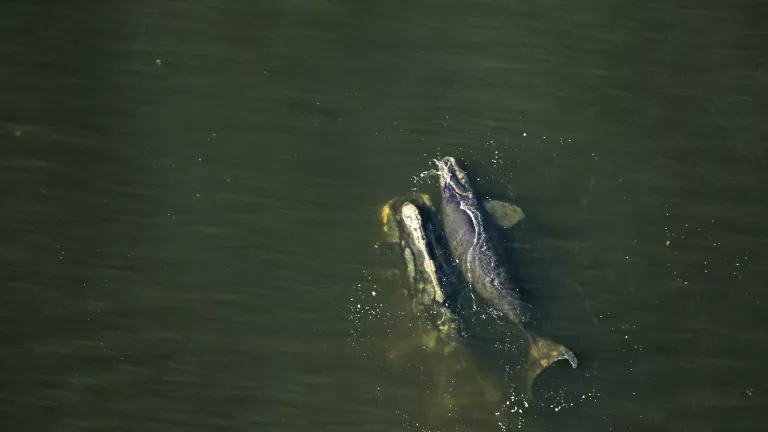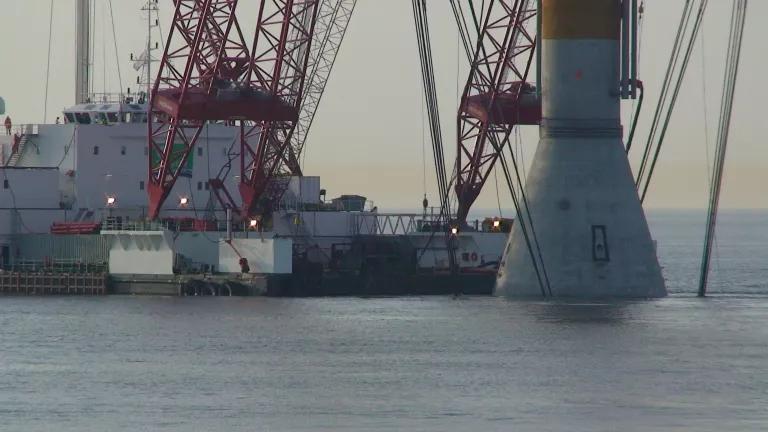
Reducing underwater noise benefits a wide range of ocean wildlife, from the largest of whales to shellfish like scallops. Loud noise, like that generated by pile driving wind turbine foundations into the sea floor, has the potential to harm marine species and interfere with their ability to feed and communicate, or follow their preferred migration path. At the same time, to avoid the worst impacts of climate change we need to scale up and quickly grow all forms of clean energy in the United States, including offshore wind power. Thankfully, there are ways to advance this exciting new industry while protecting our already stressed marine life.
Quiet foundation types that virtually eliminate noise hold great promise. NRDC’s best management practices for protecting the endangered North Atlantic right whale during offshore wind construction and operation encourage developers to select fixed foundation types and installation methods that reduce underwater noise. By opting for quiet foundations, developers could achieve these protections without observing seasonal restrictions on construction or using costly noise attenuation measures. Reducing risk to the environment also serves to reduce risk to the developer by limiting the possibility for unanticipated environmental impacts. This makes the successful deployment of clean energy in the United States more certain.
There are two main types of quiet offshore wind fixed foundation technology currently on the market: suction bucket (aka suction “caisson”) foundations and gravity-based foundations.
- Suction bucket foundations are essentially giant upside-down steel buckets sunk directly onto the seabed. A suction pump then removes the water and air from inside the bucket, which creates a negative pressure environment inside and drives the foundation down into the seabed (click here to watch video explaining this process). Once secured in the seabed, they create a stable foundation for the offshore wind turbine. Suction bucket foundations come in two forms: “mono buckets,” where a single large suction bucket is attached to the bottom of a monopile, and “suction jackets,” where three smaller suction buckets are attached to the bottom of each leg of a tripod jacket foundation.
- Gravity-based foundations are concrete foundations that can be used for wind turbines and substations, as well as other marine structures. The concrete components are fabricated locally on land and then either transported by ship or floated out to the site of installation. Once offshore, the gravity-based foundation is filled with water and sand, sinking the base so that it sits firmly on a layer of gravel that has been prepared on the seabed. It is then ready for the wind turbine to be installed on top of the foundation.
In addition to their relatively noise-free installation, these foundation types can be up and running faster, with fewer trips needed to ferry out materials. During decommissioning, the foundations are just as easily removed and reused or recycled with no steel left behind in the sea floor, unlike for pile driven foundations.

Both these technologies have been extensively used by the oil and gas industry for decades and in European commercial offshore wind projects. Some notable projects include “Vindeby,” the first offshore wind project built in Europe in 1991 (decommissioned in 2017), which pioneered the use of gravity-based foundations for offshore wind, and “Borkum Riffgrund II” in Germany that installed 20 suction jacket foundations as part of its 56 turbine project in 2018. Just last year, mono buckets were selected for the “Icebreaker Project,” the first freshwater wind project in the United States being developed in Lake Erie.
The benefits from quiet fixed foundations indicate these technologies are ready for prime time in America. We hope to see these quiet new technologies start to ‘sink in’ along our coasts.

